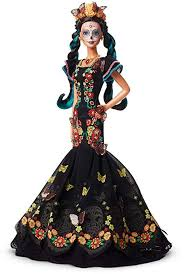Mattel applauded for diversifying their product

Amazon now carries the Day of the Dead Barbie, Mattel finally includes a doll that isn’t blonde or white. Picture from Amazon.com.
Barbie has established societal expectations for 60 years. After years of restrictions within the consumer base, on Sep. 12 Mattel released the Day of the Dead Barbie. Since the release date, there has been positive feedback across the Staples community.
Toys make up a childhood that fosters creativity and opportunity; however, some toys are only targeted to a white audience. Mattel, the creator of Barbie in 1959, has built their brand on the perfect plastic image of what it means to be a woman in the U.S, but after their new release, many students are on board with the brand and the idea that Mattel has come up with.
“I think that Barbies before, were viewed as these blonde and perfect figures, and that’s what little girls viewed as being pretty,” Ellie Doran ’20 said. “I think that’s not okay, because you don’t have to be blonde and [look] like a twig to be pretty.”
Mattel has made steps in the past to try and broaden the diversity of their product. In 2016, they released a line of Barbies with a variety of shapes and sizes, which Katie Baker ’20 believes was Mattel dipping its toes into the water of acceptance.
“I remember a few years ago, they came out with different shaped Barbies, so I can see that Mattel is taking steps to be more inclusive in their toys,” Baker said.
These Barbies altered the singular perspective of what it means to be beautiful. However, by releasing the Day of the Dead Barbie, Mattel opened up their consumer base to a variety of different cultures and ethnicities, which students believe are more relatable to the modern-day consumer who are not all blonde and thin.
By including other ethnicities and types of Barbies, young children are able to broaden their perspective on what being beautiful looks like. Riley Chlupsa ’22 believes they are teaching acceptance of all different kinds of people with all different types of looks.
“It’s nice to see that toy companies are becoming more diverse with the products they are selling,” Chlupsa said, “and with the society we live in today, I feel like diversity really helps us to progress as a unit.”
It’s nice to see that toy companies are becoming more diverse with the products they are selling.
— Riley Chlupsa '22
Because toys are used at such a young age, Julia Leitner ’23 believes it is important to advocate for these inclusive ideologies to fuel the world that we live in today.
“I think it will be a bunch of different types of dolls that they can look up to and think that they are normal when they are playing with them,” Leitner said.
While the motives for making the dolls are positive, it is important that these dolls are made so as not to offend any consumer.
“It’s really hard to find a good balance and make sure nobody gets upset,” Sasha Weisman ’23.
However, Mattel is working to continue down this path of diversity and says they have the best intentions for introducing these new dolls to young girls.
“We’re going to continue to work hard at being responsible and a better reflection of the world that girls live in today,” Evelyn Mazzocco, Mattel SVP and global brand general manager, said according to CBS News.
Because Mattel has chosen to diversify their products which have in the past been one-sided, many Staples students believe that they are taking a step in the right direction not only for young girls, but for everyone else who feels they have not been accepted by the way they look.
“I think it gives them a wider audience of different people,” Claire Gordy ’22, “and more people will want to buy the [dolls with] different races and ethnicities.”






















































